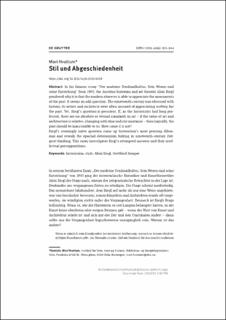Stil und Abgeschiedenheit
Journal article, Peer reviewed
Published version

View/
Date
2019Metadata
Show full item recordCollections
- Artikler / Articles [135]
- Publikasjoner fra Cristin - AHO [127]
Original version
Deutsche Zeitschrift für Philosophie. 2019, 66 (6), 831-844. 10.1515/dzph-2018-0059Abstract
In his famous essay “Der moderne Denkmalkultus. Sein Wesen und seine Entstehung” from 1903, the Austrian historian and art theorist Alois Riegl pondered why it is that the modern observer is able to appreciate the monuments of the past. It seems an odd question. The nineteenth century was obsessed with history; its artists and architects were often accused of appreciating nothing but the past. Yet, Riegl’s question is prescient. If, as the historicists had long professed, there are no absolute or eternal standards in art – if the value of art and architecture is relative, changing with time and circumstance – then logically, the past should be inaccessible to us. How come it is not? Riegl’s seemingly naïve question sums up historicism’s most pressing dilemmas and reveals the epochal determinism lurking in nineteenth-century Zeitgeist-thinking. This essay investigates Riegl’s attempted answers and their intellectual presuppositions.